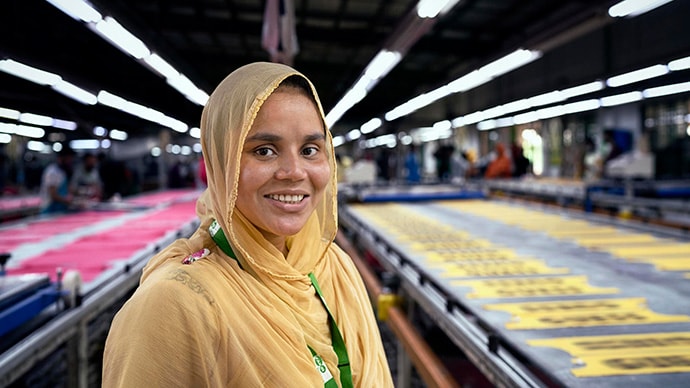by Sarah Kershaw

Moushumi works at a garment factory in Bangladesh. She says: When we finally got a toilet in our community, running water and a handwashing station in our factory, it was a massive relief. Credit: WaterAid/ Fabeha Monir
August 23, 2022
WaterAid conducted research over two years in ready-made garment factories in Bangladesh and leather tanneries in India. Our groundbreaking new report shows the results: investing in water, sanitation and hygiene increases productivity, improves health, reduces absenteeism and more.
This project was carried out with support from our corporate partners including Diageo, ekaterra (Unilever), Twinings, HSBC and Gap Inc.
WaterAid is also set to release additional findings from the agriculture and tea sectors at a later date.
Learn more about this pioneering report in this Q&A with Sarah Dobsevage, WaterAid’s Managing Director of Partnerships
Q. Tell us about this new data about clean water for garment workers and why it’s important.
SD: This report produced by WaterAid provides sound evidence that investing in water, sanitation and hygiene in workplaces and communities has a strong return on investment in employee health, productivity and on business. It pays to invest in employee health.
When apparel companies invest in clean water, decent toilets and good hygiene for staff, businesses generate a substantial return on their investment, aligning with regulation and reputational expectations and potentially influencing change for millions of consumers. That’s huge impact, at scale.
Q. What are the topline findings of the report on the apparel and leather sectors?
SD: In India, when employees had improved access to drinking water at work (30% increase) and handwashing stations (13% increase) and access to toilets at home (10% increase), absenteeism fell by 29 percent.
In Bangladesh, before the study, employees of ready-made garment factories had no household access to toilets or running water. Today, almost a third of the households (31%) now have safe water, and 26% now have toilets. Absenteeism went down by 15%, punctuality improved by 5% and staff turnover decreased by 2%.
By far the greatest return on investment was in productivity. In Bangladesh, across three garment factories productivity will increase by a projected $7.8 million over ten years with continued investment.
Assuming a continued investment in water, sanitation and hygiene over a ten-year period, the factories in Bangladesh showed an estimated overall return on investment of $6.79 for every $1 invested; in India, the figure showed an overall return of $2 for every $1 invested.
Q: What are you going to do with the findings?
SD: By sharing this information, we hope the private sector will recognize that by investing in proper water and sanitation facilities for their employees, both at work and in their communities, everyone benefits—including employees, companies and consumers. A healthy, happy workforce generates a healthy bottom line.
Consumers are searching for products with provenance. The more transparent businesses can be about their investment in employee welfare throughout their supply chains, the more attractive their products will become to the conscious consumer.
Q: Why was it important to also invest in the employee homes and communities?
SD: By improving water, hygiene and sanitation services both in the workplace and in employee communities, we were able to reach many more people through a ripple effect.
For example, in Bangladesh, the project reached around 200,000 people (50% of the people in the three target locations where the factories are), which is nearly eight times the number of people working in the factories.
Q: How long would it take for the benefits to ripple through a business’s supply chains, would it be worth the investment?
SD: The benefits became apparent very quickly, with some workplaces showing a positive return on investment after just one year. The key to success lies in investing in water, sanitation and hygiene—not only in workplaces, but also in the communities where employees and their families live.
VIDEO: Learn more about the impact of WASH (water, sanitation and hygiene) investment in this factory in Bangladesh
Reposted with permission from WaterAid. Learn more.